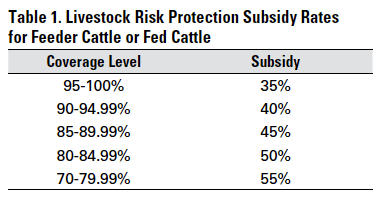Recognizing Livestock Danger Security (LRP) Insurance: A Comprehensive Overview
Browsing the world of animals threat security (LRP) insurance coverage can be a complex endeavor for numerous in the farming industry. From just how LRP insurance functions to the numerous protection alternatives offered, there is much to reveal in this detailed guide that could potentially shape the way animals producers approach risk management in their businesses.

Exactly How LRP Insurance Policy Functions
Periodically, understanding the mechanics of Animals Danger Protection (LRP) insurance can be complicated, however breaking down exactly how it functions can give clearness for farmers and breeders. LRP insurance is a threat management device made to shield animals producers versus unforeseen rate declines. It's essential to note that LRP insurance is not a revenue warranty; instead, it focuses solely on rate danger protection.
Eligibility and Coverage Options

When it pertains to coverage options, LRP insurance policy uses manufacturers the flexibility to pick the protection degree, coverage duration, and endorsements that finest suit their danger monitoring requirements. Protection degrees typically vary from 70% to 100% of the anticipated finishing worth of the insured livestock. Manufacturers can also choose coverage periods that line up with their production cycle, whether they are insuring feeder livestock, fed livestock, swine, or lamb. Recommendations such as cost danger defense can additionally customize protection to safeguard versus unfavorable market fluctuations. By comprehending the qualification standards and insurance coverage choices available, livestock manufacturers can make informed choices to manage risk effectively.
Pros and Cons of LRP Insurance Policy
When reviewing Livestock Threat Defense (LRP) insurance coverage, it is essential for livestock manufacturers to weigh the advantages and downsides integral in this danger management device.

One of the key advantages of LRP insurance coverage is its capacity to provide defense against a decrease in animals rates. This can help secure producers from monetary losses arising from market variations. In addition, LRP insurance coverage provides a level of versatility, permitting manufacturers to tailor coverage degrees and plan durations to suit their specific requirements. By securing in an assured cost for their livestock, manufacturers can much better take care of threat and prepare for the future.
Nevertheless, there are likewise some disadvantages to consider. One limitation of LRP insurance coverage is that it does not safeguard against all kinds of threats, such as condition episodes or natural calamities. Costs can sometimes be expensive, especially for manufacturers useful reference with large animals herds. It is important for manufacturers to thoroughly assess their individual risk exposure and financial scenario to figure out if LRP insurance policy is the best threat administration tool for their operation.
Understanding LRP Insurance Policy Premiums

Tips for Making Best Use Of LRP Perks
Taking full advantage of the advantages of Animals Threat Protection (LRP) insurance policy needs critical planning and aggressive threat management - Bagley Risk Management. To make the many of your LRP protection, consider the adhering to ideas:
Consistently Evaluate Market Problems: Stay informed concerning market patterns and cost fluctuations in the animals market. By keeping track of these elements, you can make enlightened decisions regarding when to buy LRP insurance coverage to protect against prospective losses.
Set Realistic Protection Levels: When choosing protection levels, consider your production expenses, market price of animals, and prospective risks - Bagley Risk Management. Establishing reasonable protection levels makes sure that you are sufficiently protected without overpaying for unneeded insurance policy
Expand Your Coverage: Instead of relying only on LRP insurance, take into consideration diversifying your dig this danger monitoring techniques. Incorporating LRP with various other danger administration tools such as futures agreements or choices can offer detailed coverage against market uncertainties.
Review and Readjust Insurance Coverage Regularly: As market conditions change, occasionally review your LRP protection to guarantee it straightens with your current danger exposure. Readjusting insurance coverage degrees and timing of purchases can assist maximize your threat security method. By complying with these tips, you can maximize the advantages of LRP insurance policy and safeguard your livestock operation versus unanticipated threats.
Verdict
Finally, livestock threat protection (LRP) insurance policy is a beneficial tool for farmers to manage the monetary dangers linked with their animals operations. By comprehending just how LRP functions, qualification and insurance coverage choices, in addition to the advantages and disadvantages of this insurance coverage, farmers can make educated decisions to protect their resources. By very carefully thinking about LRP costs and implementing methods to make the most of advantages, farmers can reduce potential losses and make sure the sustainability of their operations.
Animals producers interested in obtaining Animals Danger Defense (LRP) insurance coverage can check out a range of qualification standards and protection choices customized to their specific animals operations.When it comes to coverage options, LRP insurance policy offers manufacturers the flexibility to choose the coverage level, protection duration, and endorsements that ideal suit their danger administration needs.To realize the details of Animals Threat Security (LRP) insurance fully, recognizing the aspects influencing LRP insurance coverage premiums is critical. LRP insurance premiums are established by numerous components, including the protection degree chosen, the expected price of livestock at the end of the protection duration, the type of animals being guaranteed, and the size of the coverage duration.Testimonial and Adjust Coverage Consistently: As market conditions transform, regularly evaluate your LRP protection to ensure it aligns with your current threat exposure.